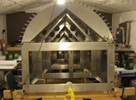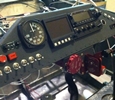


random user submitted photo
Radio interference
14 posts
• Page 2 of 2 • 1, 2
Re: Radio interference
I ran two shielded wires to the DPST switch (one from each magnetron). Attach the braids and center conductors to the switch such that the switch will control two separate circuits. Attach the braid and center conductor to the magnetron body and p lead terminal.
I crimped the shield the same as I did the center conductor and used heat shrink tubing for extra support.
This will probably work fine, but having a good dedicated ground connection between the magnetron body and the engine is probably a good idea since the spark jumps to the engine block and has to make its way back to the magnetron body to complete the circuit, jumping over potentially bad connections all the way. Mine seems to have grounded fine through the accessory plate without a dedicated ground wire to each magnetron (verified with an ohm meter), but that might not be the best practice.
If you're using a shielded wire, there's no reason to attach it to ground anywhere in the cockpit. The instructions show it that way because they use the airframe ground to complete a circuit that you are already completing with the shield.
I crimped the shield the same as I did the center conductor and used heat shrink tubing for extra support.
This will probably work fine, but having a good dedicated ground connection between the magnetron body and the engine is probably a good idea since the spark jumps to the engine block and has to make its way back to the magnetron body to complete the circuit, jumping over potentially bad connections all the way. Mine seems to have grounded fine through the accessory plate without a dedicated ground wire to each magnetron (verified with an ohm meter), but that might not be the best practice.
If you're using a shielded wire, there's no reason to attach it to ground anywhere in the cockpit. The instructions show it that way because they use the airframe ground to complete a circuit that you are already completing with the shield.
- gammaxy
- Posts: 600
- Joined: Wed Sep 04, 2013 9:31 am
Re: Radio interference
Try disconnecting the alternator wiring, fire it up and see if this eliminates your problem. Its not at all uncommon for internally regulated alternator internals to go bad and cause the noise you are hearing, even though it is still putting out power correctly. The rule for wiring is to use shielded wiring and ground one end only at the source of the signal except for the headset jacks. I would recommend that anyone unfamiliar with aircraft wiring get a copy of this book by Bob Nuckolls http://www.aeroelectric.com/Catalog/pub/pub.html#P-Book and join the forum. The book is also available on Amazon. If you have setting adjustments on your radio, those are a good place to start also. I had a 3 screen Garmin set-up in my RV-10 with a loaded IFR panel and 2 radios. I had zero wiring experience but followed the basic rules of wiring and used all aircraft grade standard wiring, no junk surplus stuff. A lot of the surplus stuff may have been stored improperly and have internal corrosion of the metal all the way through the roll. Yes, I bought a roll to save money and had to throw it out! Use shielded wire where required or suggested. Every ground went to a grounding block on the FW except for avionics back-shell shield wire grounds. No air frame grounds. Even though some seem to get away with it, grounding at the grounding block reduces your chances of RF interference. I only had one RF issue in my RV-10. I used a non-aviation grade shielded 8 wire wire bundle to wire my elevator trim tab motor.. It had a couple extra unused wires so I used those to power my LED tail position light on my rudder. Everything tested out fine on the ground without the motor running, but when I fired up the engine and turn on the position lights, RF noise was in the headset. I clipped the wires to the LED tail position light and ran a new separate shielded wire to power it and the problem was solved. Good luck trouble shooting your issue.
David Clifford
Howell & Gladwin, MI
RV-9A: Under Construction (I'm a repeat offender!)
RV-10: Built & Sold: Flying Since 2013 N959RV
Cozy MKIV: Built & Sold: Flying Since 2007 N656TE
Howell & Gladwin, MI
RV-9A: Under Construction (I'm a repeat offender!)
RV-10: Built & Sold: Flying Since 2013 N959RV
Cozy MKIV: Built & Sold: Flying Since 2007 N656TE
-

9GT - Posts: 58
- Joined: Tue Apr 05, 2016 4:23 pm
- Location: Howell, MI
Re: Radio interference
Darick wrote:I feel stupid asking this but...
I'm in the process of hooking up the primary ignition switch with shielded wire. Center wire goes to switch terminal using spade crimp-on connector (nothing new here it's just like all the other switches), other end goes to the P lead.
I don't know how to handle the shield wire the best way...connect it to my "forest of tabs" which is located on the inside firewall? I know only one end is to be connected.
If yes, does anyone know if a picture or video exists showing a good technique for attaching the braided shield to a connector? Then what? You would have to extend that connector to the "forest of tabs" with another wire. Seems messy and not very elegant...not that wiring is elegant but I'm a neat freak.
I need a jump start with this.
Hi Darick
For the manetron P leads connection I terminate the screen at the switch end. Its more convenient as it can just double up on the ground connection a short distance away at the other side of the ignition switch.
I use two bits of heat shrink to tidy the screen up. A small one covering the screen to insulate it, then a short larger diameter piece maybe 10mm long over the screen and cable over the Y junction of screen and center core. At the magnetron end trim the screen short, then cover the remaining exposed screen with heat shrink. For the connections just put a crimp lug on each end.
This youtube video shows how to separate the screen and centre core by pulling, or threading the core back through the braid. Try to not cut the strands of the braid.
https://www.youtube.com/watch?v=agJJkhXStHY
Steve
Sonex 892
Steve
Lazair kit 1981 sold
Sonerai 2LS plansbuilt 2003 sold
Sonex kit 2010
Sonerai 2LS project rotax 912
Lazair kit 1981 sold
Sonerai 2LS plansbuilt 2003 sold
Sonex kit 2010
Sonerai 2LS project rotax 912
-

sonex892. - Posts: 414
- Joined: Tue Oct 27, 2015 12:32 am
Re: Radio interference
Unless there is extenuating circumstances, general engineering best practices/recommendation is to ground the shield on the side that has the most possibility of making the noise. The shorter route to get that noise into the ground(sink), the better for the system. My P-lead shield goes directly from the side of the ignition coil (leaving 1/8" of non-shielded P-lead) to the forest of tabs. The forest of tabs then has a direct cable to batt negative. My Jab3300 regulator grounds directly to batt negative, not to the tabs, since probability of regulator noise is very high. No capacitors and no radio noise on my plane so far after 4 years. The battery is like a big sponge, it is the most effective method to get rid of noise.
Lorin
Lorin
- ldmill
- Posts: 90
- Joined: Mon Nov 21, 2011 2:30 am
14 posts
• Page 2 of 2 • 1, 2
Who is online
Users browsing this forum: No registered users and 18 guests







